13 Product Prioritization Frameworks & How to Pick the Right One
What features you should prioritize in a product is one of the toughest questions a product manager can face. Even seasoned PMs struggle with this despite decades of experience and impressive portfolios.
Many product prioritization frameworks promise to help you fix this issue. However, being created by various experts in specific industries, their applications are far from universal.
You need to find the right framework for your product team and apply it correctly. If you don’t, it will do more harm than good.
To help you do it right, we’ve hand-picked today’s ten best product prioritization frameworks and sorted them by ideal use case. We also outline key considerations to help you choose the right framework for your team.
What Is a Prioritization Framework?
A prioritization framework makes the product team’s job easier by singling out specific criteria and applying formulas that identify priority product features. It aims to drive better decisions, reduce bias, and speed up the process of choosing what to work on.
Most frameworks take various aspects of a product into account, including scope, cost, timeline, impact, and necessity. The goal is to help you strike the right balance so you get the best return on your development efforts — easier said than done, of course.
A good framework can also make communication (and negotiations) with stakeholders easier. Finding common ground is easier when you have already agreed on foundational criteria.
For example, suppose you’re focused on speed of delivery and a minimum viable product. In that case, you can quickly postpone the end user’s idea to “use AI” until a later product version.
Why Are Prioritization Frameworks Important?
We probably don’t have to tell you this, but it’s really hard to get everyone on board with a concrete direction for a product. It doesn’t matter if it’s your company’s first feature or your 50th. The product team and all shareholders rarely share a comprehensive product vision.
Naturally, feature prioritization is a huge issue for today’s product managers. In a 2022 survey of 2000 product managers by ProductPlan, 43% said they struggled most with prioritization and planning.
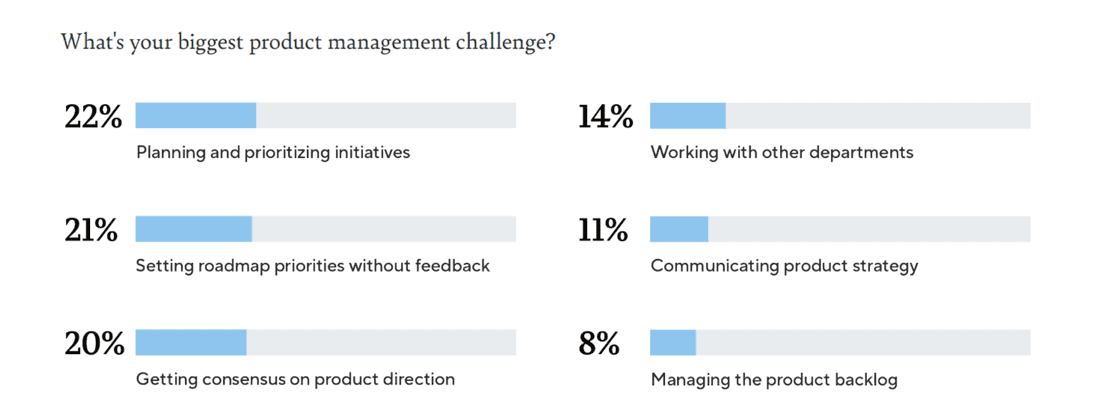
Plus, 20% said “getting consensus on product direction” was their #1 issue. To us, this seems like a euphemism for poor prioritization and communication. So, we could even say it’s 63% if we wanted to be hyperbolic.
The need is obviously there. But a prioritization framework isn’t like a glass of water to a thirsty product manager. It’s more like a tool for digging your own well. The product team has to work together on it for it to have any positive effect on the end product or release.
That work starts with figuring out which framework is right for your team. Easier said than done.
The 10 Best Prioritization Frameworks by Use Case
Below, you can find our ten favorite prioritization frameworks, but they’re not listed in order. No single framework is right for every product, team, and industry. So, instead of numbering the list, we’ve highlighted a practical use case for each framework.
This should help you quickly find options relevant to you (at least, that’s the goal).
1. ICE
Best Framework for Smaller Software Teams
Invented by Sean Ellis (author of Hacking Growth) as a tool for growth teams, ICE is a prioritization framework that focuses on moving fast. It considers the three factors of impact, confidence, and ease.

-
Impact: How much will this feature impact the KPI it’s targeting — user engagement, for example?
-
Confidence: How confident are you that the feature will have this impact?
-
Ease: How much effort is required to create the feature in a way that leads to the desired impact?
The formula is simple. First, you score the feature in each category on a scale from 1–10. Then, you multiply each score by the next. This gives a lot of oomph to the speed score, as should be expected framework born in the world of growth hacking.
In product management, it’s mostly used by smaller teams in industries where speed is crucial. For example, slowpokes are rarely awarded in SaaS (software as a service). If you don’t adopt the latest flavor-of-the-year features (like generative AI in 2024), you risk losing a significant chunk of your user base.
Pros
- Less complicated than other frameworks.
- Create fast-moving product teams.
- Helps you identify high ROI features with limited budgets.
Cons
- Relies heavily on guesswork (also known as “estimations”).
- Focuses on a narrow range of factors.
Suitable for:
Most suitable for smaller startups that want to develop fast and smaller product teams in companies with limited resources.
2. RICE
Best for Tech Products with Large Scope
The RICE framework goes more in-depth than ICE. It also factors in reach (not just impact, confidence, and effort).
Reach is your best estimate of how many users the planned feature will affect. For example, let’s say it’s a part of the custom report tool that only 25% of users use. If you have a total user base of 1,000 monthly active users, the maximum estimated reach would be 250.
RICE also uses a different scoring system for the other factors. You estimate the impact on a scale from 0.25 (minimal) to 3 (massive impact). The confidence score is a percentage of your confidence in your ability to get that impact, not a number score.
Finally, the effort is a concrete measurement in RICE. It’s specifically the work output of one team member per month — or “persons per month.” So, if you have eight developers and estimate it’ll take them two months, that’s an effort score of 16.

The formula itself is also different. You multiply the reach score with the impact and confidence scores, then divide by the effort score.
Pros:
- Gives a detailed view of each feature’s potential impact and effort.
- RICE scores consider the size of your user base.
- The concrete scores are good for communicating with stakeholders.
Cons:
- Based purely on estimates.
- RICE scores vary wildly from company to company, so there are no reliable benchmarks.
Suitable for:
RICE is most suitable for larger product teams with a more extensive user base in SaaS or consumer tech.
3. Cost of Delay
Best for Companies in Fast-Moving Industries or that Use SAFe (Scaled Agile Framework)
Great product managers understand the importance of the “first-mover advantage.” If you can develop a new feature that helps you break free from competition, you’ll etch your product into consumers’ brains. Just consider the iPhone — 16 years later, Apple is still a leading smartphone manufacturer thanks to Steve Jobs’ bold first move.
Less experienced product managers have a hard time evaluating the market impact of releasing certain features at a later time. That’s where the cost of delay (CoD) framework comes in.
In CoD, you map out the economic impact of a potential feature against the time it’ll take to develop it. You then do the same analysis for the same feature later.
You can do a linear analysis, but with missed market opportunities, the impact is often completely non-linear. The difference between becoming a market leader in a new niche and the 9th competitor is significant.
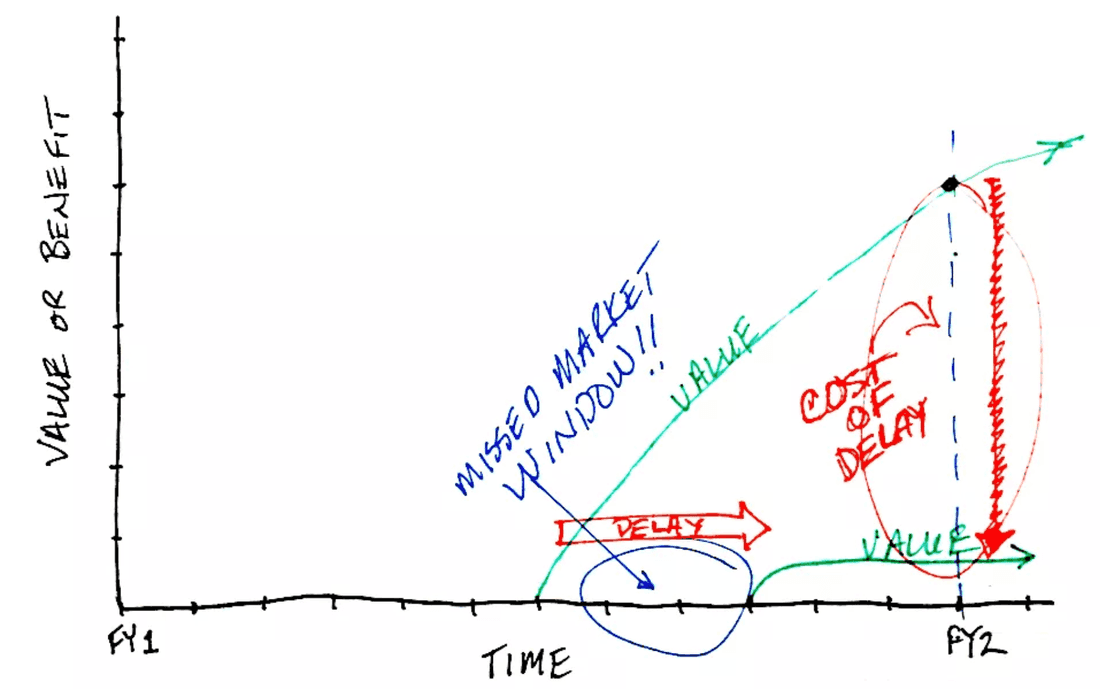
Pros:
- Can help you prioritize high-impact features early and often.
- Helps you stay ahead of competitors.
- Can establish you as a leader in new markets.
Cons:
- Results vary wildly based on who makes the estimates — it’s easy to over or underestimate the market potential. (Innovative minds didn’t just invent the iPhone, but also Juicero, the $700 wifi-connected juicer that pressed juice out of a pre-packaged bag).
- Can lead to disjointed development scheduling.
Suitable for:
It is most suitable for companies in fast-moving industries, where delayed release of features costs you customers. The cost of delay framework is also an important part of the Scaled Agile Framework. So, if your company uses SAFe, CoD analysis should be part of your toolkit.
4. Value vs. Effort Matrix
Best for Pragmatic Teams that Use Lean or Lean Agile
The value vs. effort matrix is one of the oldest and most basic approaches to feature prioritization. You map out a two-by-two matrix, with one axis for value and one for effort.
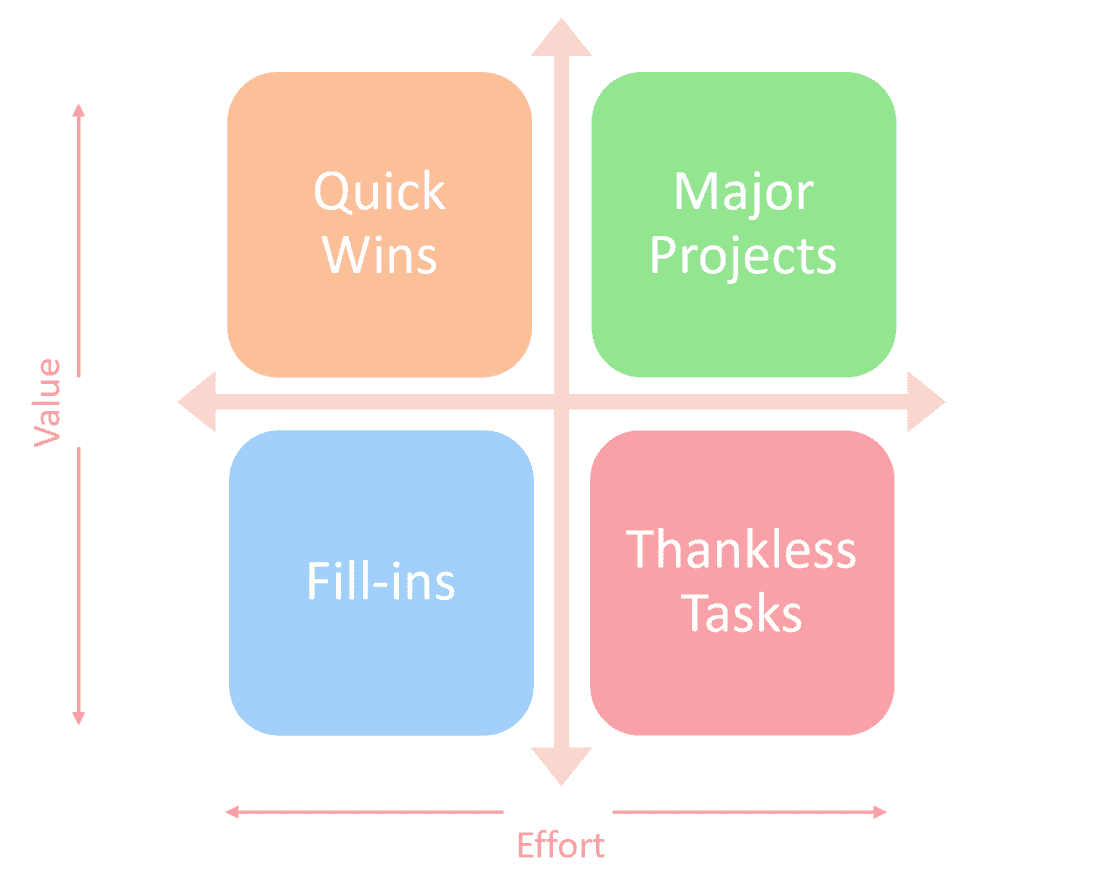
You can then take your list of dream features and plot them out on the matrix, effectively sorting them into dos and don’ts. Low-effort, high-value features are quick wins, while high-effort, high-value features represent major projects.
The bottom end of the matrix you want to avoid if possible. In a best-case scenario, they’re fill-in tasks, but often, they turn out to be arduous, thankless tasks.
Here is an example of a feature prioritization matrix where you plot out features to visualize the effort, cost, or timeline against value or impact.
Pros:
- Helps with visualizing a hierarchy of feature importance.
- Very easy to do in a meeting or workshop.
- It’s fast.
Cons:
- Only considers two variables.
- Relies on very rough guesswork.
Suitable for:
The value vs. effort matrix can be a good choice for Agile and Lean teams who want to move fast. Other teams can also use it as a preliminary method to sort features or product ideas.
5. Kano Model
Good for Products with Large User Bases
The Kano model (developed by Noriaki Kano) sorts features into five categories: must-have, performance, attractive, indifferent, and reverse. To do so, customers are asked to complete a detailed questionnaire.
Using the results, you plot the features on a 2x2 grid, with one axis of customer satisfaction and one of functionality (or investment).

Must-haves (called must-be features by Kano) are the features that help users do the basic actions promised by your product. Example features would be receiving and storing messages for a messaging app. This alone isn’t enough to delight users, only enough that they’re not dissatisfied. These often require the most work, as bad implementation renders your product unusable.
Performance features are those that require a lot of effort but also greatly improve the user experience. It follows the linear notion of hard work paying off.
Attractive features generate a lot of excitement without being too complex to develop. Think of the buzz some of Snapchat’s seasonal filters have generated over the years.
Features that customers aren’t excited about are in the “indifferent” category. At the same time, features they actively don’t want are in the “reverse” or dissatisfaction category.
Pros:
- Puts more of a focus on users and customers.
- Doesn’t rely on guesswork, but customer surveys.
- Helps you create engaging products.
Cons:
- Requires a significant number of surveys.
- Takes a lot of time and effort.
Suitable for:
The Kano model is most suitable for companies with a large user base to interview. It’s also ideal for companies developing consumer software or apps.
6. MoSCoW
Good for Early-Stage Development Projects
If you’re still trying to conceptualize what your product will look like, the MoSCoW method can help.
It’s a simple framework that sorts features into must-haves, should-haves, could-haves, and won’t-haves.

The categories are somewhat self-explanatory. Must-have features are those without which your product (or release) can’t effectively perform its function. If you’re releasing a version with a customizable UI design, you can’t do that without things like changeable color schemes.
Should-have features are crucial for a good user experience. In an auto-backup example, integrations with Google Drive or Dropbox make a lot of sense. These features typically get scheduled for future releases, following the must-haves.
Could-have features would be nice but aren’t that important. Think integrations for less-used platforms.
Won’t-have features are either irrelevant to a release or don’t have enough impact to be worth pursuing.
Pros:
- It’s simple.
- It’s easy to do in a single meeting.
- Helps create a logical product roadmap.
Cons:
- Doesn’t consider dimensions beyond impact.
- Easy to overlook outside stakeholder opinions.
Suitable for:
Most suitable for early-stage product teams.
7. Opportunity Scoring
Best for Companies in Highly Competitive Industries
Opportunity scoring in product management is rooted in the outcome-driven innovation (ODI) method that business consultant Tony Ulwick created in the 1990s.
It revolves around asking your customers two questions, with the answer being a scale from 1–5:
- How important is this feature to you?
- How satisfied are you with the current product experience?
The scale ranges from not at all important/satisfied (1) to extremely important/satisfied (5).
To calculate the opportunity score, first, calculate the percentage of respondents who answered 4 or 5 to both importance and satisfaction. Then, insert the percentages into the following formula:
OpScore = Importance + max(Importance - Satisfaction, 0)
The resulting data will allow you to map out each feature in a scatter plot (called the opportunity landscape by Ulwick):
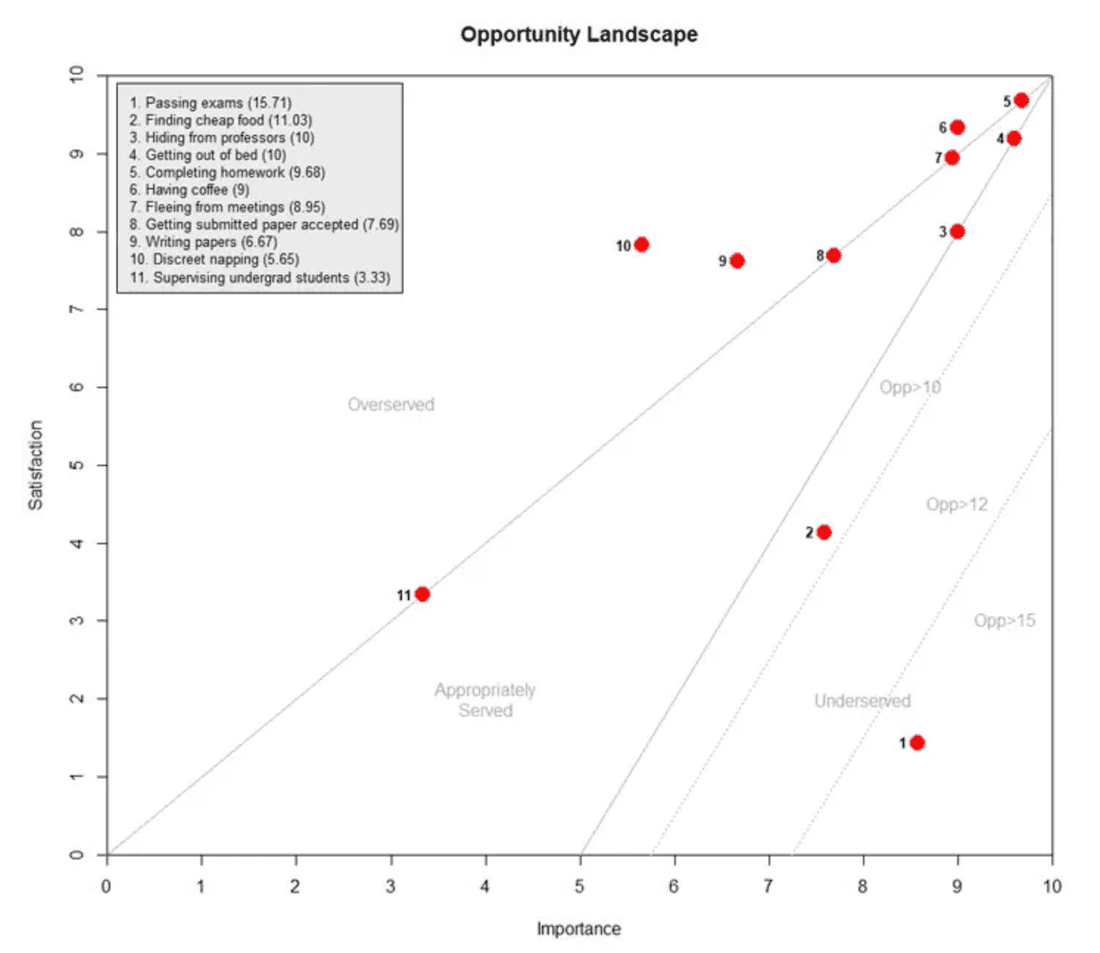
Pros:
- Uses actual customer research.
- Helps visualize feature hierarchy by user demand.
- Makes it easy to identify low-priority features.
Cons:
- Survey responses don’t always accurately reflect consumer attitudes.
- Somewhat time-consuming.
Suitable for:
Most suitable for companies in highly competitive industries.
8. Story Mapping
Best for Planning a Cohesive User Journey from Day one
In 2008, developer and Agile enthusiast Jeff Patton coined the term “story mapping” in a blog post about mapping out a product backlog with a colleague.
Explained simply, it’s a technique for arranging an uncategorized backlog of user stories into a more cohesive roadmap for development.
You first consider the logical usage sequence and map it out in a basic linear fashion. Then, you add the factor of criticality (how often the feature will be used by how many users). You then use this to map out the best way to prioritize features in order of urgency and sequence.
Below, you can see the example Jeff used in his first article on the subject from 2005:
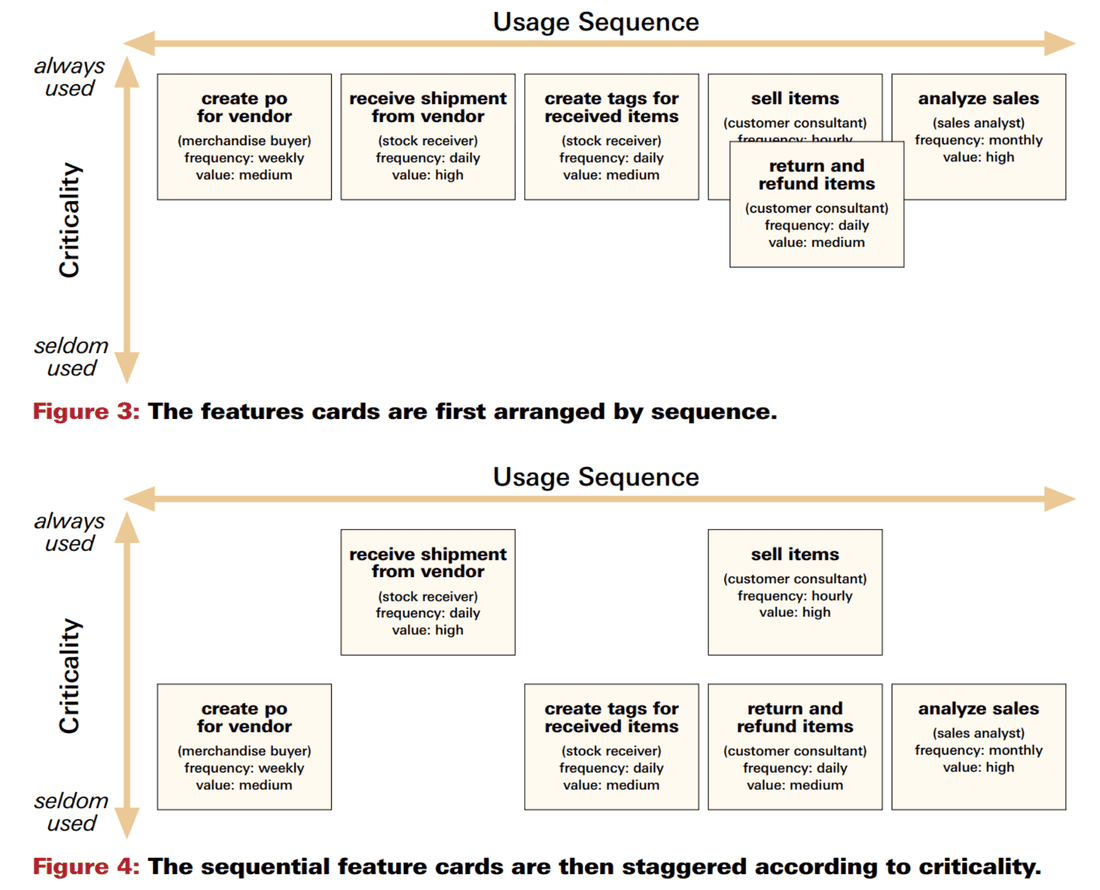
Yes, it’s another 2x2 grid, but the basis for the axes is different from previous matrices. You then use this to map out a development timeline or story map, which should look more like this:

Pros:
- Slots well into Agile teams (except those that are borderline religious Scrum followers.)
- Creates a cohesive development journey, not just disjointed releases of priority features.
- Puts the needs (and real usage) of end users first.
Cons:
- Typically limited to what exists in the backlog.
- Does little to offset the biases of the creators of the map.
Suitable for:
Agile teams in an early stage of development that are looking to plan out their product in a cohesive way.
9. Product Tree
Best for Workshops in Large Companies with Many Internal Stakeholders
The product tree (also called “prune the product tree”) is an interactive game developed by Luke Hohmann, a market research expert.
In it, you create a visual tree on a whiteboard (virtual or physical), where the trunk represents the product. Roots represent the required tech stack, branches crucial features, and leaves are new feature ideas.
To play the game, set up a workshop with at least 5–10 internal stakeholders in the product. If you have more attendees, split into multiple groups of 5–10 members. Then, ask them to envision what the product should look like in three to five years.
After the various teams have done this, you go over the different trees and work to “prune” the trees into an ideal development path everyone agrees on.
Pros:
- Great for earning buy-in from stakeholders.
- Helps your team think outside of the box.
- More engaging than a typical meeting exercise.
Cons:
- Highly speculative.
- You need active participation from many stakeholders to get a worthwhile tree.
Suitable for:
Most suitable for larger companies with many internal stakeholders.10. Buy a Feature
Best for Engaging External Stakeholders
Buy a feature is another option with a more workshop or game approach (vs. a fixed framework), which can be used through every stage of your development journey.
In this game, you give stakeholders a fixed amount of money to buy features and price the features based on your best estimates of their development cost.
Pros:
- It’s highly engaging and interactive.
- Helps you understand the priorities of your stakeholders.
- Great for refining an already established product.
Cons:
- Too simplistic for many use cases.
- Can make compromise and unified visions more difficult (not easier).
Suitable for:
Buy a feature is best for teams that want to better understand the priorities of their external and internal stakeholders.
11. PIE
Best for Simple Yet Effective Prioritization
The PIE framework is a straightforward tool for prioritizing product features and tasks. It helps product teams allocate resources efficiently by focusing on Potential, Importance, and Ease of implementation.
This approach simplifies decision-making and ensures that efforts are directed towards tasks that will have the greatest impact.
Pros:
- Easy to understand and implement.
- Balances potential success, importance, and ease.
- Uses both quantitative and qualitative data to make informed decisions.
Cons:
- Scoring can be subjective.
- May not account for all variables in complex projects.
Suitable for:
Small to medium-sized product teams looking for a clear and efficient prioritization method without getting bogged down in complexity.
12. ABCDE
Best for Quick Prioritization
Developed by productivity expert Brian Tracy, the ABCDE method helps you focus on what truly matters by categorizing tasks based on their importance and urgency. This framework helps you tackle your most critical tasks first, enhancing your overall productivity and efficiency.
Following the alphabet’s first 5 letters, your tasks should be classified as A - Very Important, B - Important, C - Nice to Do, D - Delegate, and E - Eliminate.
Pros:
- Distinguish between crucial tasks and less important ones.
- Encourages you to handle high-priority tasks first.
- Easy to understand and implement.
Cons:
- Task categorization can be subjective.
- May not account for the complexity and nuances of certain tasks.
Suitable for:
Improving task management and productivity through a straightforward prioritization method. This framework is particularly useful for those who want to focus on high-impact tasks and reduce time spent on less important activities.
13. Weighted Scoring
Best for making data-driven decisions
The Weighted Scoring Model is a robust decision-making tool that helps organizations evaluate and prioritize various options by assigning relative weights to different criteria based on their importance. This method allows teams to make rational and objective decisions, minimizing personal biases and ensuring that choices align with organizational goals. To calculate the weighted score, you need the following:
- Criteria. These are the factors used to evaluate alternatives. Criteria should be relevant, measurable, and aligned with organizational goals. For example, a company evaluating suppliers might consider price, quality, and reliability.
- Weights. Relative importance assigned to each criterion, reflecting their significance in achieving organizational objectives. For instance, if cost is a priority, a higher weight might be assigned to the price criterion.
- Scoring Method. Technique used to assign scores to alternatives for each criterion. This can range from numeric scales (e.g., 1-10) to qualitative ratings (e.g., high, medium, low).
Pros:
- Reduces the influence of personal biases and emotions.
- Provides a structured framework to compare and rank options.
- Helps in efficiently allocating resources.
Cons:
- Assigning weights and scores can still involve some subjectivity.
- Can become complex and time-consuming.
Suitable for:
Organizations needing to evaluate multiple options against diverse criteria, such as project selection, product feature prioritization, or strategic planning.
How to Choose the Right Prioritization Framework
Before jumping into the list, let’s quickly cover what factors decide whether a framework is a good fit for your team. Familiarizing yourself with them upfront will make it easier to choose well and avoid wasting time on a bad fit.
Scope, Team Size, and Number of Stakeholders
The product’s scope, the team’s size, and your stakeholders should be top of mind when choosing a framework.
You don’t need the level of complexity of many advanced frameworks if you’re a 5-person startup team with a single outside stakeholder.
If the scope is small, you don’t need a complex framework for a larger project team. Nobody wants to complete a 15-minute Kano survey to plan a minor internal note-sharing app.
Stage of Development
Where’s your product in the development cycle? If your product is live (or in beta) and you have active users, active product feedback will play a more important role.
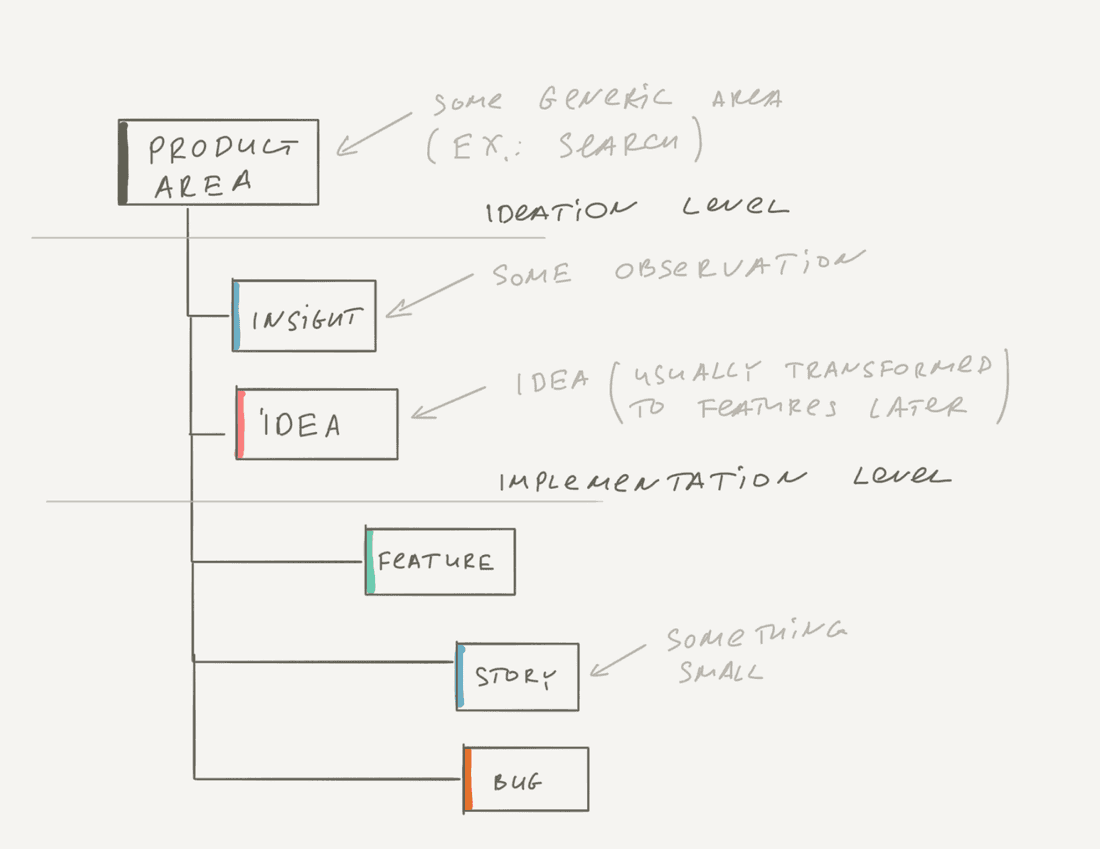
Don’t work off assumptions if you don’t have to. If you can ask actual customers for their opinion, do so.
Of course, the customer isn’t always right in product development — or at least, every customer isn’t. You must filter varying opinions and identify underlying reasons, not just take their word for it.
When possible, pair surveys with reviews of actual product use (or a similar one) to compare opinion vs. reality.
In a development stage where end users can’t give an opinion, you can use frameworks that focus on internal stakeholders instead.
Your Overall Product Goals
You need to find a framework with criteria that line up (more or less) with your overall product goals.
For example, if your product meeting spec is a matter of not being sued or losing big clients, a speed-focused framework is not a good fit.
So, choose a framework that broadly reflects your overall goals and criteria. You can adjust any formula to better represent how you value different criteria to get them to match your OKRs more closely.
The PM’s Hot Take
Phew, you are spoiled for choice now, right? If you’ve read carefully, you also see that there’s just no silver bullet when it comes to prioritization frameworks. Seek and you will find - or in other words, if you understand the challenge you are currently facing, we are almost certain you will find the right fit. If not, let us know and we’ll lend a hand.
How Do I Set My Prioritization Framework Up in Fibery?
Fibery is a no-code platform to help you create a unique workspace tailor-made to your product management processes.
But that doesn’t mean you have to start from scratch. With our product management template, you can hit the ground running with a built-in feature prioritization tool that supports RICE, MoSCoW, and WSFJ. It also includes a feature roadmap, backlog, epic board, and many more out-of-the-box features.
If you’re using RICE, all you need to do is input your estimates for reach, impact, confidence, and effort. Our software handles the scoring and plotting with no tedious spreadsheet magic required.
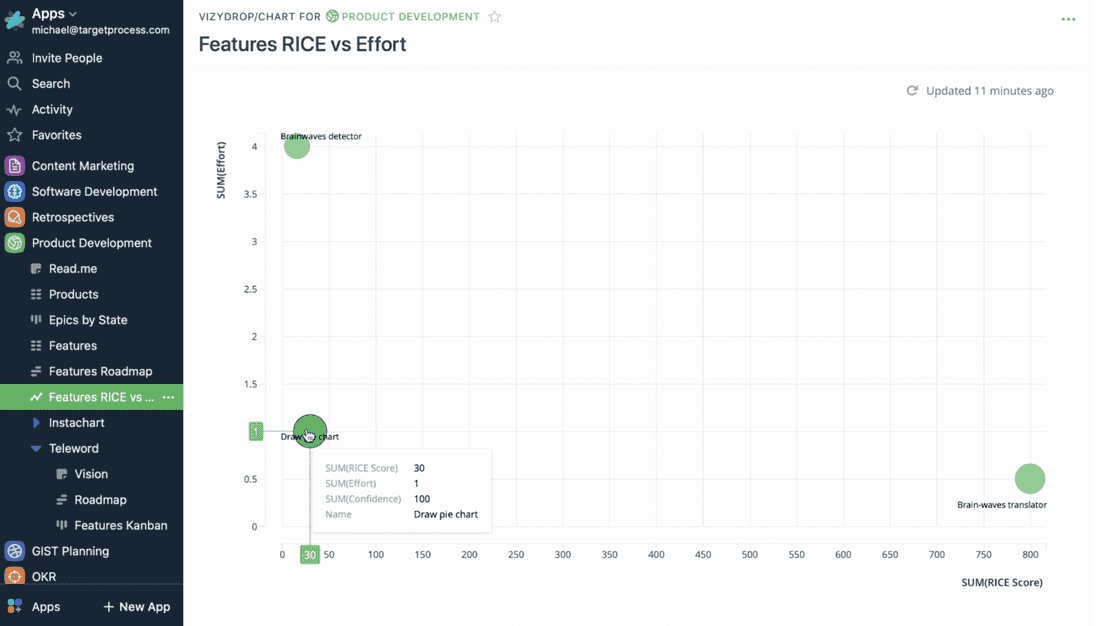
If you’re using MoSCoW or WSFJ, input the relevant criteria to see features in a different visual hierarchy. You can also create a completely custom formula that matches your framework of choice.
What makes Fibery different (and special) is the extent of customizability — you can easily adjust the prioritization formula or framework to suit your process. We’re not an opinionated product management tool that tries to tell you how to work. We let you create the best platform for how your team already works.
And with robust integrations with go-to-market tools, we help you eliminate silos and create a more holistic product management process. Try Fibery for free and experiment with your prioritization framework of choice.
Go Beyond Abstract Frameworks with Fibery
While a prioritization framework can help your high-level decision-making, implementation can be a bit of work unto itself.
Silos between multiple SaaS apps and desynchronized teams often get in the way of a united front in product development. What ends up getting prioritized is often despite input from developers, sales reps, and end users.
To avoid this, you can use Fibery to create a digital home for your entire product management team — including outside marketing, sales, and customer support stakeholders.
Build a comprehensive system for managing user feedback, building a backlog, and prioritizing features that align with your OKRs. By adapting our templates, you can easily map features using multiple frameworks and prioritization matrices.
Try Fibery for free and experience what it feels like to be able to put product management ideas into action.
Psst... Wanna try Fibery? 👀
Infinitely flexible product discovery & development platform.